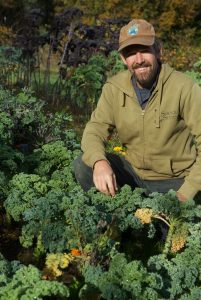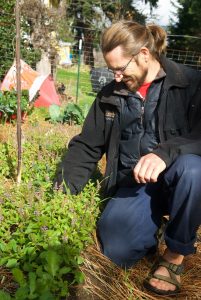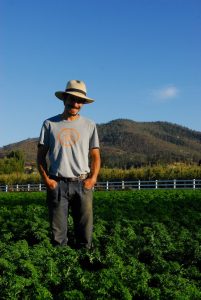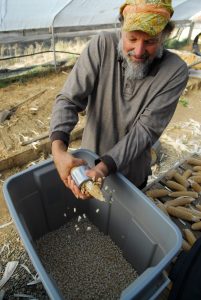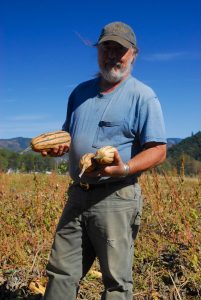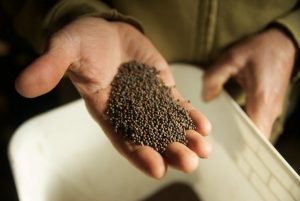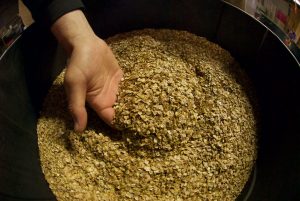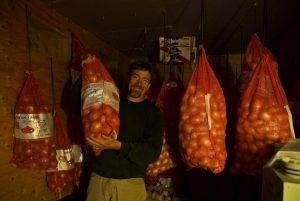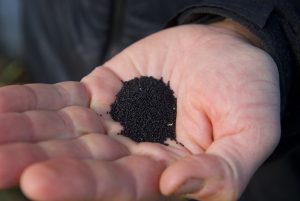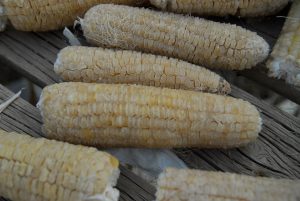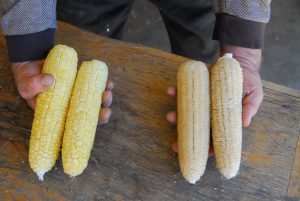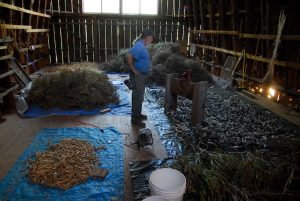Final report for FW15-018
Project Information
Roll-out of our SOSGA project programming was smooth in general, although in the first phase of this project we also hit a few small obstacles during implementation. Each of those served to teach us things and to better our programs, which should be attributed to the sound leadership and the many friendships within our group. The necessity of making changes to our plan and budget helped us to gain increasing experience functioning as a team, and showed us early on us how agile we can be in making adjustments and improving our programs and strategy.
Now a few years in with this organization, we feel that SOSGA can make good use of future opportunities, and that we are generating solutions to some of the issues facing the small seed grower. Regarding our Project Goals, the Accomplishments and Impacts sections, below, are the best scorecard for our group.
Thanks for your key support.
Project objectives (directly from 2014 Grant Proposal)
(1) Maud Powell will convene and facilitate 18 bi-monthly Seed Network meetings around southern Oregon, hosted by farmers and accompanied by an on-farm workshop, presentation, or demonstration (May 2015 – December 2017). Six field events for 2015 have been proposed, to be confirmed by seed grower association members at 2015 general membership meeting (February 2015)
- The on-farm, public field days were immediately successful and have been a widely appreciated part of SOSGA’s programming. The full 18 events were successfully convened, with attendance ranging from 10 to 50+ with an average of about 20 attendees per event. In 2018, the final five events were as followed, with attendees in parentheses: Seed Winnowing Demo (22), Garlic Tour (22), Seed Cleaning Demo & Tour (19), Bioregional Seed Operation Tour (18), Medicinal Herb Seed Production tour (43).
- All cash payments have been promptly mailed to host farmers after event completion. Our farmers have appreciated that.
- Powell and SOSGA board members convened regularly for the purpose of charting out the SOSGA Seed Network events.
- A different farmer hosted each field day, so the events helped spread attention around the valley and they motivated seed farmer visits to other farmers’ operations and fields.
- Powell’s management gave this program everything it needed. She did a fantastic job planning the program and making it go. Examples were her skillful program development, effective public outreach, and practiced event facilitation.
2) Don Tipping will mentor three beginning seed growers during the 2015 and 2016 growing seasons. He will visit each grower two times per season, offering practical advice and feedback to mentees (May 2015 - November 2016)
- We designed and launched a new mentorship program in 2016, a development which we communicated to SARE along the way. We received very positive feedback from program participants about the mentorship interaction “format” and about the budget as re-designed, with this in it.
- In year 2016 we were able to support 4 one-to-one relationships in our valley between new seed producers and veteran mentor producers, and in 2017 we facilitated another 3 relationships. The mentors found it worth their time, as well as gratifying, and mentees all bonded through the program, too. So we social capital and the growth of support networks as an additional yield of the program.
(3) Chris Hardy will plan and host two spring regional seed exchange events (April 2016 and April 2017). He will coordinate and moderate a public Rogue Valley seed farmer panel on the history of open-pollinated plant breeding and seed production in the Rogue Valley. Hardy will promote the seed exchange and panel to the public and farmers through six Facebook groups, with event page and follow-up materials reaching 50,000-200,000 online readers
- Hardy managed the agreements with the hosting venue (the Ashland Armory) and led the way through all event and attendee logistics. The spring 2016 seed exchange was publicized to gardeners, farmers, and local seed supporters the Rogue year. It took place Thursday March 31 2016, from 3-730 pm, and over 50 people attended. We expect to continue this event and function in the future, and predict an ongoing upward trend in attendance in the coming years. We see this as a sign of our seed messaging reaching broader audiences in our region, and of the interest in small farm seeds work continuing to grow.
- The event built camaraderie among our grower members. SOSGA members attended to host exhibition tables of their seeds and any related causes or companies they represent (their personal seed companies, non-profit organizations like the Open Source Seed Initiative, etc.). SOSGA had its own table, staffed by a rotation of the younger SOSGA grower members. SOSGA also oversaw various seeds related demos, from seed cleaning to fun educational kids activities.
- The events were photo-documented and circulated by multiple SOSGA member users through Southern Oregon social media networks (Facebook, especially).
(4) Eric George will upgrade crop pollen mapping system to open source GIS platform (free), to enhance SOSGA's pinning map quality and enable the measurement of isolation distances and new spatial quantitative data analyses (April - June 2015)
- George and Andrew Schwarz split efforts and pay on the pollen mapping system to successfully transition the map user interface from a multi-file BatchGeo map set to a single-plane interface, choosing the user-friendly Google Maps platform. SOSGA is continuing to gather and maintain Southern Oregon regional seed geospatial information as the leading seed institution in the area; and this is a regional function that all members agree SOSGA should and will retain into the future.
- We mapped locations and created detailed metadata for all existing SOSGA paid-member growers; locations of other known or possible seed production sites in our valleys; and locations of major produce farms that merit attention from the point of view of pollen contamination potential… e.g. any winter and summer squash production on produce farms, un-mowed acreage of bolting brassica produce crops, un-mowed rows of bolting Beta vulgaris produce crops
- This mapping system is now embedded in the SOSGA website interface, where it looks great and is highly usable. We've made it public so that established seed growers, but especially new ones, can learn where other growers are located, and who their seed producing neighbors are. In this way, new growers can do more due diligence to ensure that they are not inadvertently encroaching on other growers' isolations, and likewise, be assured that their own geography is suited to the seeds/pollen that they are interested in producing.
- SOSGA seed map here: http://sosgaseed.org/seed-field-maps/
(5) Eric George and Chuck Burr will improve the SOSGA website and increase the organization’s online presence. Projects will include a thematic bibliography for seed production, breeding, and business skills, as well as current news and research. George will collect key references for the bibliography form SOSGA members (November 2015 – March 2016)
- Similar to decisions about our Mapping component (described above) the SOSGA Board identified the need for an enhanced web site and high quality online ‘landing place’ for seed professionals and for the interested public. We also wanted to transition the website away from a custom-created and managed HTML site (pioneered and maintained by seedsman Chuck Burr), since that meant that all website updating responsibilities would have to fall to the SOSGA members with web site programming skills.
- With Burr’s assistance, Hardy took the lead on bringing the website forward one substantial step. And in the past year, hte organization used its own funds to contract with an independent professional website designer. The new web site is much more photographic and visually engaging, and represents our SOSGA growers in a professional and positive light.
(6) Eric George will research seed cleaning set-ups and systems for different-scaled operations and produce a written report. George’s publication will be posted on the SOSGA website and presented in person to prospective and experienced seed farmers at the Eco-Farm Conference in January 2017 (December 2015 - January 2017).
- George teamed up with SOSGA President and co-researcher Andrew Schwarz to visit, tour, and interview 6 seed farmer SOSGA members. The first round took place in fall 2015, when we visited with Jonathan Spero, Sebastian Aguilar, & Steve Florin. In a second round of interviews, in fall 2016, we met with Tom Powell, Don Tipping, & Chris Hardy. Schwarz and George have both made additional visits and research follow ups (substantially traveling in my case) late September 2017, early-mid February 2018, and July 2018.
- George has produced rough draft stage SOSGA seed farmer Profiles that situate each growers’ seed processing set-up within their strategic seed goals, opportunities, and limitations for their farm. Maud Powell is helping George to edit and hone the profiles so that they read well together, and so that the text functions in the best way for its primary audience (growers). George and Schwarz are returning each farmer profile to each profilee, prior to publishing them together. In this way we hope to be accountable to our member growers and to make sure that we haven't omitted or messed up any important pieces of their stories and profiles.
- Schwarz took the time code through recorded voice interview files that we captured, searching for the best quote-able nuggets to include in the grower Profiles, as in-paragraph quotes, or as side boxes throughout the report.
- Schwarz did the photography and contributed high quality farm and farmer profile photos to include in the research publication. Like with the writing, above, Schwarz is also delivering these photographs to the grower-members themselves, for use in their own seed and farm marketing and promotion.
- Our research has shed light on equipment sharing programs, cooperative ownership schemes among young seed growers currently “tooling up,” and the choices around which enterprises and seasonal crops fit well as farm labor and space-filling activities complementary to production seed growing. Our understanding of ourselves as an organization continues to evolve, and so the research has informed our thinking about what, for us, represents "appropriate technology" with regards to seeds processing. It has entailed taking a closer look at our particular marketing relationships, and where within our systems and processing we are getting consistently bottlenecked and missing profit potential.
- We already are applying this research, as demonstrated in SOSGA's recent investment in shared seed processing equipment. Compared to when we started, we now have a clearer view about what acquisitions would be most appropriate for our group of growers, and why. As discussed in earlier reports, we re-allocated money originally set aside to purchase a Belt Thresher, to instead purchase a tool much more appropriate for our context: a new instrument designed by Mark Luterra, in Oregon, called the "Winnow Wizard." Our research and analysis made it clear to us that Belt Threshers, while seemingly quite useful on their own terms, represents a class of tools that only marginally meets the needs of most of our growers. Problems include the reality that belt threshers need extensive and meticulous clean-outs between lots, and as a result, in effect require substantial-sized lot minimums. The mismatch is that most of our growers specialize in supplying their seed customers with a higher diversity of smaller-size, higher value lots. Thus the seed clean out labor is consequently spread across too few units of seed processed. Additionally, regarding cooperative usage -- the threshing step in the production process is a particularly time sensitive one, and within the same bioregion, many growers' seed harvests come due in the exact same seasonal windows. As you can imagine, with the very time-sensitive nature of harvest for quality seeds, this presents some logistics and sharing issues for group ownership of a Belt Thresher.
- The Winnow Wizard, on the other hand, is a terrific fit for SOSGA growers.
- It boasts a simplified, streamlined seed handling flow, for no substantial nor daunting clean outs;
- Elimination of the lot-minimum issue for proper payback with the cleaner;
- A smaller initial price tag, and much cheaper and more technically accessible for ongoing maintenance;
- Access and openness, thanks to creator Luterra, to a constantly improving WW prototype and small-lot-processing innovation pipeline; and
- A long potential window of use by growers, because it's for the "finish cleaning" stage, rather than a more urgent activity like threshing (so this smooths out the demand-timing issue).
- Now, in 2019, a group of SOSGA growers are taking next steps towards systematizing how to share this equipment. So far the Winnow Wizard has primarily been deployed as a mobile unit for farmers to utilize at their own operations. A multi-day, advance-scheduled "check out" system and calendar is being formalized. Another important idea is to create a logbook that will document seed lots that have been cleaned, which reduces errors and raises accountability among the group. Such a logbook also will produce information about the machine's usage, and the amount of value that SOSGA growers are getting out of the investment in the shared equipment. Seed grower Sebastian Aguilar brings notable experience to this effort, from his experience developing a shared, mobile seed processing approach several years ago in northwest Washington. Over the years numerous Rogue Valley seed growers have informally shared and made available their individual farm's seed processing machines and so this new effort with the Winnow Wizard already precedent in our area, and that foundation of experience has informed the process. This story and timeline of re-evaluating our collective tool purchase plan is but one example of how our research findings are already affecting the ways we are thinking about growers' needs and our organization's potential.
Cooperators
Research
Impacts
Professionally and as a community, most Southern Oregon Seed Growers Association (SOSGA) members have benefitted from the advancement of this organized growers' platform. This Western SARE project served us well. We thank you.
Your Farmer-Rancher funding infused our early farmer-to-farmer programming with the capital and energy needed to carry out a satisfactory and educational year of activities, and to put SOSGA firmly on the map in Southern Oregon, both in public awareness and in the local producers community.
Through the project, monitoring and feedback have improved our programming. We've made a number of adjustments in the organization, many of which we didn’t concretely foresee in 2013, in SOSGA's first meetings.
Some of these ideas have emerged slowly, from ‘economies of scale’-farmer cooperation thinking, and have lead us to discuss cooperative equipment sharing arrangements, co-marketing initiatives, seed purity isolation planning, and similar ideas. There are past examples for many of these initiatives, which is valuable in pooling our ideas and strategizing the best ways to approach things.
One of our proudest innovations belongs under its own heading: ideas around mentorship and new farmer incubation. The farmer field days-based seed network and the one-to-one mentorship relationships are two initiatives that have inspired trust, goodwill, and optimism without our organization. They work from the core of SOSGA’s essential character and its strengths. We originally thought that our organization possessed a difficult stumbling block and conundrum: that SOSGA is not a wholly homogenous group of growers, and especially that some are experienced and carry reputation whereas other members are newbies, or merely prospective. Instead of this growing as a tension, through activities like these our programs help pair new growers with our valley’s more seasoned ones. Over 3 years, SOSGA’s veteran core served to attract the next generation to the table -- we found a healthy fit.
It has been a beautiful, emergent twist and progression to watch and be part--that among this multi-generational cast of characters, we are finding the clarity to carry SOSGA forward to its next stage. SOSGA's growers value organic seed integrity, seed quality, and plant biodiversity; and we're grateful to SARE for enabling us to solidify our organization while pursue these values.
Accomplishments
Milestones achieved or in progress, as directly outlined in grant section titled "Producer Adoption," pp. 8-9, Dec. SARE 2014
"These questions will guide monitoring of project progress along the three-year project duration, and will provide the primary framework through which this grant will be evaluated at project conclusion." George, p. 9, SARE 2014
Has there been a measureable increase in seed sales revenue for the region’s beginning and young seed growers?
- Our programming has directly opened markets for new young producers. From the "soft" networking opportunities, to the "hard" production and contracting informational sessions, opportunities are being created that young and beginning seed producers are making use of. The seed production reputations and apparent marketing savvy of SOSGA's younger seed growers has been on display at the biennial Organic Seed Growers Conference, held in Corvallis, OR. At this conference, most of our growers arrange contracts with buyers and flesh out their seed production; and our beginning and younger producers are sought after at the national level. Younger and prospective seed growers in other regions will be attracted to the learning and training opportunities afforded by Southern Oregon, and in this way there are systems-level benefits, when a region like Southern Oregon succeeds with training, formation, and incubation of upcoming quality seed producers.
Do seed producers have the equipment, spaces, and processes needed to clean and grade seeds to deliver high-quality commercial seed lots?
- Our research is showing that each veteran seed grower has developed and equipped their own processing system to achieve their seed goals -- which should be viewed always within their overall, specific farming scenario and life situation. The younger growers have numerous models now to view as they figure out how to match their seed equipment set-ups to the specific goals they have as a producer, and our research paper will be adding to this knowledge set. Seed equipment sharing also to a certain degree already occurs among the SOSGA growers network. SOSGA plans to continue investigating and investing further in making sure our growers have the right seed post harvest processing tools and spaces for viable seed farming. We are on the lookout now for next "high-potential opportunities to share and add value to our farms. The Winnow Wizard introduction, at this point, serves as a prime example of want to offer more of.
Has the seed farmer field day program increased camaraderie among regional seed growers and SOSGA members?
- People had fun while learning a lot. The Seed Network field days program consistently drew a healthy mix of general public attendees along with farming professionals and dues paying SOSGA seed growers. These every-other-month convergences engendered camaraderie in myriad ways--among others getting out to each others' fields; converging briefly for a beer in Jacksonville after an event; establishing the basis for a later email technical question from a younger grower; learning who our "go to" producer experts are for given crops ... there are many avenues to that result. Yes, camaraderie has been an apparent outgrowth of these network happenings.
Have the field days enhanced awareness among the general public about the Rogue Valley’s seed farmers, their growing methods, and where to buy their products?
- SOSGA has grown in the public's awareness right in-step with two regional ballot measures relating to small seed producers’ rights in southern Oregon. This very much got SOSGA on the map, publicly, in the beginning. We also link tightly with OSU Extension, through project Technical Advisor Maud Powell, so we feel our programming and media is reaching and serving our desired audience and beyond. Evidence of public awareness and interest includes: excellent mixed attendance at on-farm field days, numerous publicity and requests for members speak on seed politics issues, and requests by the local master gardeners guild about how its members could buy seeds directly from Southern Oregon seed growers.
Are any farmers actively referencing their affiliation with the SOSGA network as part of their marketing and PR presence?
- We had a memorable, camaraderie-rich photograph, taken at the 2016 springtime SOSGA seed exchange in Ashland, featured in the front inside cover of one of our members' 2017 seed catalogs.
- SOSGA members have been able to use their SOSGA affiliation in certain situations as additional credibility in matters of seed, and to build new partnerships around organic seed supply. This has probably helped our more junior members the most. Several SOSGA members have, in part through their work with SOSGA, earned positions on additional non-profit Boards of Directors and operating committees. Overall we feel our members are making more effective business connections in the seed world because of pieces of support offered by SOSGA.
- Some members, for example, will cite their isolated seed growing location as part of their marketing package and approach, relating this function to the genetic purity and integrity of the seeds produced. The fact that SOSGA maintains regional seed geographic information helps buttress growers' rights and claims today and, in the face of future threats, defend local growers’ sites and valleys moving forward.
Have more event organizers and conference coordinators sought out SOSGA seed growers to serve on information panels?
- This is definitely happening. However it is difficult to measure whether this increased demand for our members as speakers has been caused (or not) in part by the individuals links with SOSGA membership and activities.
Have SOSGA members noticed measureable increases in requests for technical consultation or other seed expertise services?
- Same as above. The answer, however, is that yes: we believe the trend is upward.
Is the number of visits to the SOSGA website increasing each year?
- Hardy has taken the lead this year on the online re-presentation of SOSGA. The web page is more visually striking and photographic, and we continue to add content. The addition of a SOSGA facebook page additionally serves to highlight and expand on SOSGA activities, it also works as a portal for more casual web goers, who may then visit our official SOSGA site. The same process is true of the OSU Extension email list, through which the 18 farmer field days were announced and disseminated. Through direct searches and through indirect avenues like these two, we expect website hits to keep increasing as our organization continues to embed in the community locally, and generate further buzz.
Research Outcomes
Education and Outreach
(first two seed exchanges supported by Western SARE)
Participation Summary:
To flesh out the numbers above:
- 7 consultations: This number comes from two years' operation of our mentorship program. Experienced seed producers have counseled and spent time with young seed growers, 4 relations in year 1 and 3 relations in year 2. Each of these sessions included many more interactions than just one single "consult" per relation. Rather each relationship was budgeted for 10 hours of the mentors' time, and almost all 7 fulfilled that. Thanks to the mentors, and for our highly engaged, up and coming producers.
- 18 on-farm demonstrations / field tours / workshop-field days: These public events on SOSGA seed grower member farms (and a few non-SOSGA registered farms) have been conducted for three to four years now, the first taking place July 2015. There have been many topics covered -- typically with the focus of a given workshop/field day/tour integrated into a site tour of the host farmers' operations. The topics offered have given our area's farmers more opportunities to share what they have have to offer the community, whether that be unique approaches to small farm management or the stories of their careers in agriculture, which can be useful to younger growers and aspirants.
- 2 "talks" or presentations: both of these took place at the SOREC extension center (OSU extension), so indoor in a workshops space rather than on producer farms. We had two different presentations like this. First, in June 2015, owners and seed buyers from 5 established organic seed companies presented to a good sized group about business norms and how to improve practices in wholesale seed contracting. In February 2016, on the heels of a popular, nearby seed conference, we recruited sweet corn breeder Dr. Bill Tracy to speak to us (same venue) about plant breeding processes and quality seed production best practices.
- The final 2 events, filed under "other," are our seed exchanges, which combined public outreach and education with local seed genetics dissemination. Held in one of progressive towns in our region, Ashland, the seed exchange bundled these functions into a forward-looking, rural-spirited cultural celebration. Both SOSGA seed exchanges that SARE sponsored were well attended (spring 2016 & 2017), and we co-produced a third seed exchange this past spring 2018 in Ashland. We felt the events were successful on each level, as above, and received positive feedback from members of the public.
Education and Outreach Outcomes
Quality organic vegetable seed production
Proper and seed isolation and seed quality assurance
Farm systems and business design: for integrations of seed production and vegetable production on working farms
Small-scale, diversified Seeds Harvest and Post-harvest processing: tools, spaces, workflows, and strategies ...designing for suitability to particular farm situations and holistic life contexts
Vegetable seeds business: both the Retailer ("seed company") roles and the Seed Grower roles, with the most business and economics information shared for the latter category (farmers/growers)
Particular knowledge, by crop group or farming style: seed crop fundamentals, harvesting, and processing ... for example, for Medicinal Herbs, for Small Grains, for Seed Garlic, for Biennial Vegetables, Dry Farming, etc
